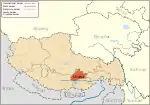


Chagpori, Chakpori, Chokpori, Chagpo Ri (Wylie: lcags po ri, literally "Iron Mountain") is a spirit-mountain of Vajrapani[1] within the city of Lhasa in Tibet. It south of the Potala and just to the left when one is facing the Potala. It is considered to be one of the four holy mountains of central Tibet.

Chagpori was the site of the monastic medical college of the same name founded there by Sangye Gyatso in 1696. This medical college, which incorporated a recently restored temple made by Thang Tong Gyalpo, was supplied with revenue generating lands and with a constant stream of students by a "monk tax". It remained an important medical institution in Tibet and Central Asia up until the mid-Twentieth century.[2] Peter Aufschnaiter was photographed by Heinrich Harrer on top of the College of Medicine (Men-Tsee-Khang) using a theodolite for surveying the city of Lhasa.[3] Aufschnaiter wrote, "Since 23 December 1947 I have been staying in Lhasa for some months to make a town plan, and have now been appointed to the government service by a decree of the Regent."[4]
During the March 1959 Lhasa uprising, the medical school established by the Thirteenth Dalai Lama named Men-Tsee-Khang and a temple housing statutes of coral (Tsepame), mother-of-pearl (of Tujechempo) and turquoise (of Drolma) were demolished by the People's Liberation Army artillery as the Tibetans had placed a few cannons up there.[5][6][7] Jianglin Li's book Tibet in Agony: Lhasa 1959 says,
"On March 20 (...) That was the morning of the shelling of Chakpori Hill. While the Tibetan Medical Institute crumbled..."[8]
The monk Jampa Phuntsok of the Namgyal Monastery recalled,
"when the bombardment of Chakpori Hill began (...) the Tibetans at the Potala could only watch as their beloved landmark went up in smoke."[9]
It is now crowned by radio antennas.[10][11] A road has been constructed through the spur that used to connect Chagpori with the Marpori ('Red Hill') on which the Potala is built. At this spur connecting these two hills was the famous chorten Pargo Kaling, a spired reliquary with an arch that served as the town's western gate and was demolished in 1967 and rebuilt in 1995.[12]
Some rebuilding has since taken place a number of old rock carvings have survived through damage. Some of them are thought to have been carved during the reign of king Songtsen Gampo (605 or 617? - 649 CE) and painted by Nepalese artists.[10] Some buildings have been rebuilt near the base of the hill and there is now again a small temple with prayer wheels.[13]
Tradition has it that the three main hills of Lhasa represent the "Three Protectors of Tibet." Chagpori is the soul-mountain (bla-ri) of Vajrapani, Pongwari that of Manjushri, and Marpori, the hill on which the Potala stands, represents Chenresig or Avalokiteshvara.[14]
Footnotes
- ↑ Akester, Matthew; Mkhyen-brtseʼi, dbang-po (2016). Jamyang Kyhentse Wangpo's Guide to Central Tibet (New ed.). Chicago, Ill.: Serindia. p. 64. ISBN 9781932476606. LCCN 2016950295. OCLC 780335376.
On the Chakpo-ri, sprint-mountain of Vajrapani, (one can see) the coral image of Amitayus, pearl image of Mahakarunika and turquoise image of Tara established there by Tangtong Gyelpo
- ↑ Meyer, Fernand. (2003). "The Golden Century of Tibetan Medicine" in Lhasa in the Seventeenth Century: Capital of the Dalai Lamas, p. 111. Brill, Boston. ISBN 90-04-12866-2.
- ↑ Peter, Aufschnaiter (2002). Brauen, Martin (ed.). Peter Aufschnaiter's Eight Years in Tibet. Translated by Walshe, Maurice. Brauen, Martin. Bangkok: Orchid Press. p. 98. ISBN 9745240125. OCLC 917234693.
Peter Aufschnaiter taking measurements from the roof of the College of Medicine in Lhasa, photographed by Heinrich Harrer. (Film 61, frame 10)
- ↑ Peter, Aufschnaiter (2002). Brauen, Martin (ed.). Peter Aufschnaiter's Eight Years in Tibet. Translated by Walshe, Maurice. Brauen, Martin. Bangkok: Orchid Press. p. 15. ISBN 9745240125. OCLC 917234693.
Since 23 December 1947 I have been staying in Lhasa for some months to make a town plan, and have now been appointed to the government service by a decree of the Regent.
- ↑ Dowman, Keith. (1988). The Power-Places of Central Tibet: The Pilgrim's Guide, p. 49. Routledge & Kegan Paul Ltd., London. ISBN 0-7102-1370-0.
- ↑ Lobsang Gyatso, Memoirs of a Tibetan Lama, Snow Lion Publications, 1998, ISBN 1-55939-097-2, p. 262 : "The Tibetan government had one of two cannons on the top of the Chakpori hill near the Potala".
- ↑ Travelin Tibet Archived August 28, 2011, at the Wayback Machine, Going in circles: "The Tibetans placed their few cannon up there and the Chinese destroyed the place."
- ↑ Li, Jianglin (2016). Tibet in Agony: Lhasa 1959. Wilf, Susan. Cambridge, Massachusetts: Harvard University Press. p. 278. ISBN 9780674088894. OCLC 946579956.
- ↑ Li, Jianglin (2016). Tibet in Agony: Lhasa 1959. Wilf, Susan. Cambridge, Massachusetts: Harvard University Press. p. 281. ISBN 9780674088894. OCLC 946579956.
- 1 2 Mayhew, Bradley and Kohn, Michael. Tibet. 6th Edition (2005), p. 103. Lonely Planet. ISBN 1-74059-523-8.
- ↑ French, Patrick. Tibet, Tibet: A Personal History of a Lost Land. (2003), p. 143. Alfred A Knopf. New York. ISBN 1-4000-4100-7.
- ↑ André Alexander, The Traditional Lhasa House: Typology of an Endangered Species, LIT Verlag Münster, 2013, 409 pages, p. 54: "In 1948, [...] There were no more city walls, but two gates. One was the Drakgo-kaling, a gate consisting of three stupa monuments located between the Potamla Palace and Chakpori Hill (demolished in 1967 and rebuilt in 1995)."
- ↑ Buckley, Michael and Strauss, Robert. (1986). Tibet: a travel survival kit, p. 133. Lonely Planet Publications, South Yarra, Vic., Australia. ISBN 0-908086-88-1.
- ↑ Stein, R. A. (1972). Tibetan Civilization, p. 228. Translated by J. E. Stapleton Driver. Stanford University Press, Stanford, California. ISBN 0-8047-0806-1 (cloth); ISBN 0-8047-0901-7 (paper).




